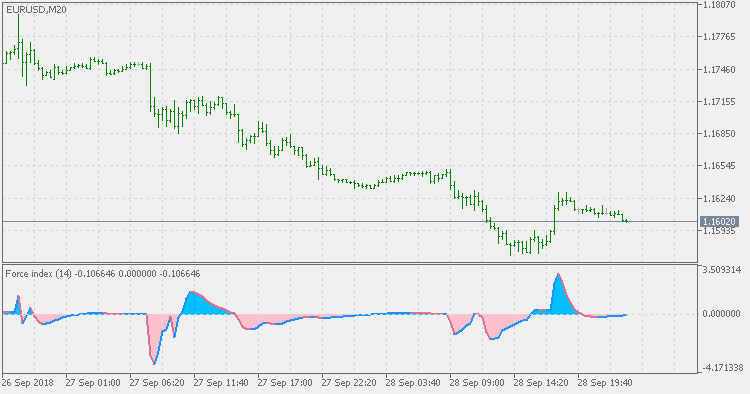Dr. Alexander Elder is one of the authors behind an upcoming technology of indicators for technical analysis. The Force Index is an oscillator that evaluates the power or force of bulls behind certain market rallies and bears accompanying each decline. The three main elements that make up the force index include the direction of price change, the magnitude of the price fluctuation, and the trading volume. If the index of force is employed with an average moving and a corresponding figure, it can accurately gauge significant changes in the strength of bears and bears. In this manner, Elder has taken an extremely effective single indicator known as the moving average and incorporated it into his force index for more accurate prediction.
Working
It is determined by subtracting yesterday's closing from today's closing and multiplying it by today's volume. If prices at the close are higher today than yesterday and the force is positive, it's positive. It is negative when closing rates are less than the previous day's prices. The force's strength is determined by a greater variation in price or greater volume. Both could influence the force as well as the variation in force index.
The force index is displayed in a histogram using zero as the line center. A rising market will result in a positive index plotted above the centerline. An unfavorable market will result in a negative index beneath the central line. An unchanged market will result in an index of force directly on the zero line. The line in the raw form drawn over the entire day histogram creates jaggedness. The moving average smooths it. So, at a minimum, utilizing a two-day exponentially moving average, also known as EMA, is recommended to get the right degree of smoothing.
Interpreting the Force Index
The general rule is that traders are likely to purchase when two days' EMA of the index is negative and trade when it's positive. However, these traders must always remember the principle that governs all trading according to 13 days EMA in terms of price. This 13-day EMA of the force index is a long-term indicator. When it crosses over the centerline, bulls are exerting more power. If it's negative, the bears control the market. Particularly important are the divergences between the 13-day EMA of price index and force, which are in line with exact points that indicate crucial moments of market volatility.
Based on closing prices that are different between yesterday's close closing price and the current one will reveal the level of day-to-day victory of either bulls or bears. The volume is also factored into the calculation to give a more accurate picture of the magnitude of the winning of bears or bulls.

What Volume and a Flattening Index Means
The volume can also indicate the amount of momentum in the market, powered by either bears or bulls. Force index is among the most reliable indicators that combine the two into one readable chart. If the force index reaches an all-time high, an upward trend will likely persist. If the force index makes an all-time low, the bears are stronger, and the downtrend continues.
A flat force index is a crucial event for traders. A flat force index indicates that the observed shift in price is not backed by declining or rising volume and the trend is set to reverse. On the reverse side of the coin, a flat index could signal a trend reversal when a significant volume is correlated with tiny price changes.
That's the most basic way the force index may be utilized on its own or with a moving mean to determine if bears or bulls have control of the market. When the volume factor is considered a good indicator, a clear understanding of the direction of the market's movement can be quickly obtained.
Force Index Limitations
Force indexes are an indicator of lagging. It uses the previous volume and price data, and the info is used to determine an estimated value (EMA). Since the data is usually combined to form an average, it could occasionally be slow in providing trade signals. For instance, it could require a few months before the force index will begin to rally after an upward breakout. Still, at this point, the price could have increased significantly over the breakpoint and therefore no longer be a good reason for an entry.
A shorter-term force index (10, 13, and 20, for instance) generates lots of whipsaws because even small price movements trigger large swings in the indicator. A longer index will not have the same number of swings, but it's slower to respond to price movements and provide trade signals.



